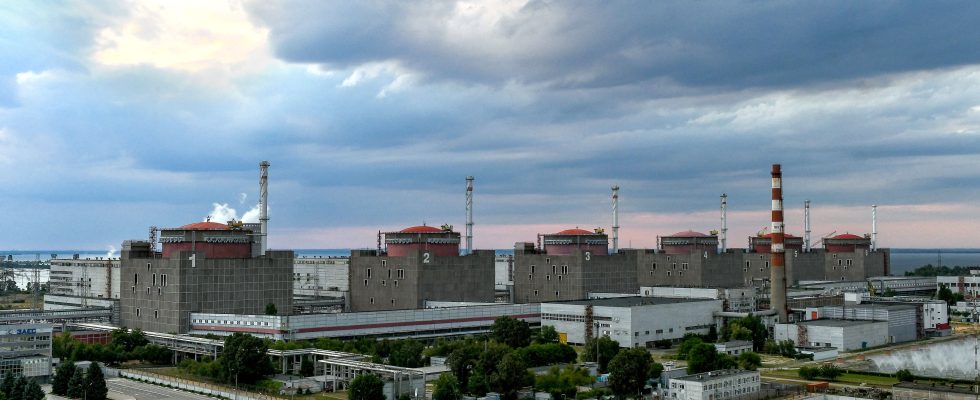The International Atomic Energy Agency (IAEA) is issuing a warning cry, after a week of bombing on the Zaporizhia power plant site: “We are getting dangerously close to a nuclear accident.” While Russia is gaining ground and its bombings have caused several deaths in recent days, several Western allies intend to release new funds, partly from frozen Russian assets, to support Ukraine in its fight against Moscow.
Information to remember
⇒ The Zaporizhia nuclear power plant is dangerously close to “a nuclear accident”, warns the IAEA
⇒ The American Congress should vote this week on a new envelope of 60 billion for kyiv
⇒ The European Union and the United States want to use frozen Russian assets to finance the war against Russia
Zaporizhia power station unstable after numerous strikes
“We are getting dangerously close to a nuclear accident” in Zaporizhia, the head of the International Atomic Energy Agency (IAEA) warned on Monday, noting that it was “impossible” to know who was responsible for the recent attacks against the Ukrainian nuclear power plant. The site, occupied since March 2022 by Russia in southern Ukraine, suffered a series of drone attacks from April 7, with Moscow and kyiv blaming each other for responsibility.
These “reckless attacks” have “greatly increased the risk at the Zaporizhia power plant, where nuclear safety is already compromised”. “Each of the IAEA’s seven pillars of nuclear security and safety have been compromised. We cannot stand by and wait for one final weight to tip the balance into an unstable balance,” added the Director General. of the UN body, which has experts on site.
A wave of bad weather causes massive outages
A wave of bad weather left tens of thousands of Ukrainians without power on Tuesday, after Russian strikes damaged the country’s main power plants, with President Volodymyr Zelensky lamenting the lack of ammunition to protect them. According to Ukrainian authorities, these attacks, which began on March 22, damaged 80% of the national electricity generation capacity. In total, 173 localities in four regions would be affected.
At least six civilians killed in 24 hours
At least two civilians, men aged 63 and 65, were killed in an airstrike on a school on Monday in the Kharkiv region (north-east). According to the governor of the town of Loukyantsi, very close to the Russian border, it was “a guided aerial bomb” which hit the school. Ukrainian authorities in the Donetsk region announced the death of four other civilians on Sunday evening in the town of Siversk. Ukraine admitted on Sunday that the situation was “tense” on the eastern front, where the Russian army is pushing ever harder to seize the strategic locality of Chassiv Yar, 35 kilometers southwest of Siversk.
Security agreement between Ukraine and Norway
Ukraine and Norway, both neighbors of Russia, have agreed on the terms of a bilateral security agreement. “Norway will provide long-term military, political, financial and humanitarian support to Ukraine,” Espen Barth Eide said after a meeting with Ukrainian President Volodymyr Zelensky in kyiv on Monday. The text will be signed and its content revealed during the next meeting between Zelensky and Norwegian Prime Minister Jonas Gahr Støre.
Biden urges Congress to pass Ukraine aid plan
Joe Biden on Monday reiterated a pressing call for Congress to adopt a budget of tens of billions of dollars in military aid for Ukraine, currently blocked by the Republican opposition. “Congress must pass this funding” for Ukraine “and it must do it now, now,” he said. A $60 billion package for kyiv has been blocked in the US Congress for months, as has another package for Israel. “Russian President Vladimir Putin “will not stop, endangering Europe, the United States and the entire world if we do not stop him in Ukraine,” said Joe Biden. Congress should vote on the project help this week.
US wants to use Russia’s frozen assets
The U.S. government hopes that the IMF and World Bank spring talks, which begin Tuesday in Washington, will advance the plan “to unlock the value of stranded Russian sovereign assets to support Ukraine’s continued resistance and its long-term reconstruction,” a US Treasury Department official said on Monday.
At the end of March, the 27 of the European Union decided to advance work on a proposal to use the profits from frozen Russian assets to finance military equipment for Ukraine. This could make it possible, from July, to release between 2.5 and 3 billion euros per year in favor of kyiv. This is not about the frozen assets of the Russian Central Bank. In response, Russia threatened the European Union with legal action “for decades” if these revenues were used.
